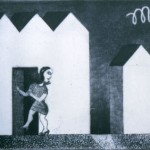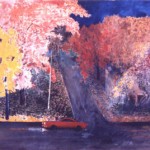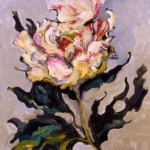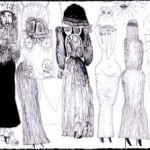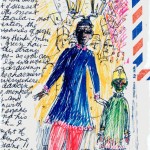RADIANT: Jimmy Wright, An Overview, 1963-2004
Jimmy Wright’s many collectors and enthusiasts quite reasonably think of him as a New York painter. Wright (b. 1944) has lived and worked in New York City since 1974, and since the early ’90s he has been celebrated for his incisive self-portraits and his luscious paintings and pastel of sunflowers. The New York Times described Wright’s sunflowers as “untrammeled images so deeply expressive that they make van Gogh’s florals look decorous by comparison,” and The New Yorker said they are “passionately unkempt”… not exactly unsentimental, but full of a writhing, macabre lushness.”
What might come as a surprise is that the geography of Wright’s past has more to do with the Midwest and the south than the environs around the Big Apple. His artistic sensibility is marked by a history that extends, by way of Illinois, back to his upbringing and early education in Kentucky. Born in rural Kentucky, Wright attended the Aspen School of Contemporary Art in Colorado in the summer of 1963, meanwhile studying art in Kentucky at Murray State Collage. The earliest images in this survey, rough little orgy scenes in ink on paper (inspired abutting sex and religion), come from his two-year period in Murray, KY, where he also had his earliest exhibitions. In 1964, Wright moved to Chicago to attend the School of the Art Institute of Chicago (SAIC), and he lived and made art there for four formative years.
As a young, quickly maturing painter and printmaker, Wright was part of the hotbed of activity that spawned Chicago’s imagist movement. He was close friends with the members of the group that called itself The False Image, especially Philip Hanson, Christina Ramberg and Roger Brown. ” fellow student, Jimmy Wright, and I had become close friends, “Brown wrote later, reflecting on the mid ’60s. “We had a lot in common ” both were southerners with the same religious background, and worked in the school storeroom. Through Jimmy I met my future cohorts in The False Image. We were all in Ray Yoshida’s painting class, but Jimmy was more socially inclined than I, and already knew more of our fellow students.”
Yoshida’s influence on all the budding imagists was strong, but there was input from other SAIC faculty, in particular Whitney Halstead. Interest in images from advertising, comics, design, fashion, and other popular cultural resources was freely mixed with tributaries from European painting and printmaking, like Odilon Redon, James Ensor and the German expressionists, as well as the new international Pop-Art movement, various self-taught artists, and bits and pieces imported from non-western art-making traditions.
Wright’s early aesthetic fits into a Chicago imagist matrix. One can clearly discern Ensor in the gritty Hog Killing sketches (all 1968), as well as the buoyant Flying Fish (1969), while the many stylized studies of women, women’s clothes and women’s hairdos all bear close comparison with the work of Hanson and Ramberg. Some of the same expressionist influences that were there in Gladys Nilsson’s first prints are evident in Wright’s gorgeous little 1966 Maxwell Street etchings. Wright has retained a looseness and expressivity throughout most of his career that perhaps marks his divergence from the mainstream of Chicago imagism, but these visually dense, humorous, sometimes popish and sexually playful pieces from Wright’s Chicago period and the years directly thereafter suggest that he should be considered an important and heretofore unacknowledged early member of the movement. It is tempting to speculate on what he would have done if he’d stayed in Chicago, shown with The False Image at the Hyde Park Art Center in 1968 and ’69, and identified himself with the imagists as they caught their wave. But he didn’t. Instead, he pursued an independent path that led him far away from the shores of Lake Michigan.
Wright graduated with honors from SAIC in 1967 and he returned for a semester of grad school. With a travel fellowship from SAIC, he left on an overland journey through Europe into Turkey, Iran, Afghanistan, Pakistan, and finally Nepal and India, where he stayed for four months. The visual impact of India, as well as its social and cultural climate, made a deep and lasting impression on Wright. In women’s veils, Wight found an image of repressed sexuality that he identified with from his own conflicted past, as a gay youth stealthily growing up in the zealously conservative religious southern U.S. “It was a kind of repression I was so familiar with,” say Wright. The slightly late lithograph Radiant (1970) is an especially nice example of how these ideas continued to bounce around in Wright’s head; in the print, he compiled veiled figures and other women copped from Kurt Weill’s Mahagonny, to which the artist was listening nonstop at the time. Wright also made ceramic and bronze sculptures of women and abstracted women’s forms, often sketching them in pencil or even etching them, then translating these preliminary images into three-dimensional finished pieces.
Back in the States, in the autumn of 1969, Wright moved from Chicago to Carbondale, Illinois, to attend graduate school at Southern Illinois University (from which he received his MFA in 1971). While in Carbondale, Wright’s work began to change somewhat, growing a bit cooler and more reserved, never losing the gesture altogether, but gradually giving images a tighter, slicker finish. Indeed, he was doing this at the same time as his Chicago cohorts were following a similar trajectory, exchanging the spontaneity of expression for a refined, but often sarcastic or ironic gloss. Some of Wright’s downstate works have just such a smirk, like the gorgeous graphite drawing of a hooker headed into a room, Motel (1972), from which he made a smaller etching, and the vacant fast-food neon sign of Eat (1972).
A major catastrophe befell Wright in 1970 when his house burned down, taking with it all the paintings he’d made while in Chicago. Left were a scattered portfolio of drawings and prints and a brain full of remembered artworks. You can see singe-marks from this inferno around the edges of the handful of remaining Chicago-era pieces, poignant reminders of the tenuousness of material existence. Wright stayed on at Carbondale for a few years, teaching, painting, and rebuilding. He made a few glorious large acrylics there, including Main Street (1972), a sweet, slightly somber landscape of a midwest street on a rainy eve.
Wright’s decision to settle in New York in 1974 was to prove an excellent one. He took to the city immediately, painting luminous night studies of the cityscape, and creating a portrait of the World Trade Center, even as the Twin Towers were being completed. Wright dove into New York’s nightlife with gusto, and his sketchbooks include uproarious images of disco club scenes; his etching Club 82 (1974) looks something like Studio 54 as it might have been rendered by Max Beckman.
By the early ’80s, Wright was painting images that directly confronted the complexities of his southern childhood. Baptism at Rives, Baptism at Pilot Oak, Baptism at Obion River and Snake Service (all 1980) deal slyly with the homoeroticism of certain religious rituals, while The Confession (1980), a major entry in his oeuvre, once again finds the influence of Ensor helping to shape a wickedly sharp group scene in which heads resembling Elvis and Jesus dot the crowd. Tiny pieces from this period, reverse-painted on glass, include The Doctor’s Exam (1985), a proctological study that recalls Chicago proto-imagist Seymour Rosofsky’s vicious 1960s oil The Inspector. A special project at the beginning of the ’90s led to a group of softer, more emotionally vulnerable monoprints (some compiled into two artist-books) exploring his grandmother’s small hometown in Tennessee.
Wright’s printing changed dramatically in the early ’90s. With the diagnosis of his partner with AIDS in 1988, Wright began work on his first sunflower, a magnificent, huge, heavily impastoed oil, dominated by browns and tans. A newfound love of pastels has resulted in many radiant sunflowers and bunches or baskets of other flowers, sometimes joined by luna moths, and this topic has also been the germ for a series of lager oil paintings. Taken with Wright’s striking self-portraits, executed in the same media as the sunflowers, these flower paintings have earned Wright an international reputation. But as Grace Glueck wrote in her New York Times review of Wright’s 2001 solo show at D.C. Moore Gallery: “These are not flowers as decoration but symbols of a deeper engagement with the vagaries of nature and self.”
The sunflower paintings bring to bear the immense wellspring of experience of a divergent Chicago imagist steeped in memories of world travel, a rich life and personal and artistic tragedy. Wright is an artist whose generosity of spirit and devilish sense of humor have kept his work from becoming ingrown or losing its vigor. Southerner, Chicagoan, New Yorker – Jimmy Wright is all of these. And at the same time he is none of them. He is an independent artist, happily so.
John Corbett
At the time I drew Radiant, I was playing Lotte Lenya’s album of Mahagonny daily. I had just read Kafka’s Amerika. Kent State had just happened and Nixon was bombing Cambodia. Radiant was a conscious response to Kafka, Brecht, Weill and Lenya. The sexual undertones in Kafka become open in Weill. A drawing and sculpture transformation series of women in burkhas was already well underway. There’s a chapter in Amerika called “The Theater of Oklahoma.” The main character encounters hundreds of women perched on ladders wearing angel wings and gowns while blowing trumpets. I remember thinking of these women in serial form as angels, earthly sirens with trumpets. I think I drew some with wings and trumpets but that may be a false memory. Later the sirens became mermaids. While traveling overland to India I remember thinking what a fragile bubble the twentieth century was when compared to the religious and economic realities of the third world. I never imagined living in the Bush “Theater of Texas.”
In Istanbul I went to a sailors’ bar with belly dancers that looked out of a Beckmann or Grosz painting. There was a steep staircase by the stage. Each new dancer would race down the stairs in high heels, propelled by the music. As she danced one of the dancers at the bar would go up the stairs with a sailor in hand. I stayed out until dawn and all the bridges were drawn up for boat traffic. To get to the hotel in the old city I hired a man in a rowboat and rowed across the Bosphorus. That was crazy, since a freighter could swamp the small boat, which had no light. I could hear the mourning call for prayers as the water lapped at the lip of the boat. One night in Afghanistan we camped out in a small village square. As we spread our sleeping bags out for the night a woman in a burkha emerged from the dark and spooked everyone. I awoke the next morning and shook a scorpion out of my shoe. I was warned by the bus driver to not go out alone or go to any of the tea houses at night. I heeded his advice as we were always meeting travelers who had been robbed in the desert” … tales of blond German girls and hippy girls disappearing. The driver and the courier were afraid I’d disappear. I looked like a 14-year-old girl. You could smell the scent of hashish in the streets at night. Young boys danced and sang on table tops. Men walked arm in arm, holding hands. How I wanted to go into those tea houses.
Jimmy Wright
These essays were published on the occasion of the exhibition held at Corbett vs. Dempsey in Chicago from October 15 to November 6, 2004.


